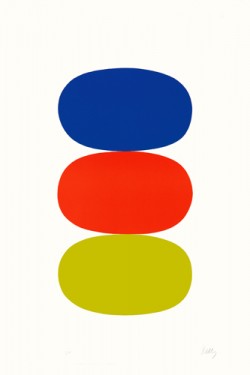Ellsworth Kelly has been described as among the most influential living artists in American contemporary art. This summer, the Portland Art Museum is giving patrons a rare chance to view dozens of works from his extensive career in printmaking.

The exhibition, titled Ellsworth Kelly/Prints, features more than 80 prints by the artist over the course of his life. Loaned to the museum from the collections of Jordan Schnitzer and his family foundation, the works will be on view through Sept. 16, at which point the exhibit will travel to other museums across the country.
“We are excited to present this full retrospective of Ellsworth Kelly’s printing career, from his very earliest prints in the 1960s, to things just a few years ago,” said Mary Weaver Chapin, curator of graphic arts for the museum. “He is one of the most important living American artists. He’s had this huge influence on generations, and this show informs this whole development of visual language and vocabulary that he uses to communicate to the viewer.”
Though Kelly’s work has an abstract quality, his prints rely on shapes derived from direct observation. By breaking down visual elements to fundamental shapes, the artist uses the interplay of bright colors and simple angles to redefine the dialogue between artwork and individual.
“Over the course of his entire career, he’s really sought to eliminate this barrier between artist and subject, and between the art and the viewer,” Chapin explained. “To do that, he’s simplified his language down to these elements of color and shape.”
Having been defined at times by critics as a hard-edge or color field painter, Kelly has often worked with rigid shapes and angular forms. His work Colors on a Grid (1976), which greets museum patrons as they first enter the gallery, displays a perfect grid formed by an array of colored squares on a 48” by 48” sheet.
Despite the hard forms comprising many of his works, the shapes in his art often work together to establish a more lively dialogue. Further down the wall from Colors on a Grid, for example, a long lithograph of four misshapen, colorful squares line up beside one another. The work, titled Blue/Black/Red/Green (2001), leaves the impression of a brightly tumbling square racing across the corridor.
“Interestingly, though some people lump him in with the group of hard-edge painters, he really hates that term,” Chapin said. “He never wanted anything cold and calculating. He always said he wanted life and joy in his work.”
Not all of Kelly’s displayed work is defined by hard-edged squares. The collection also features a central room surrounded by a collection of early color prints titled Suite of 27 Lithographs and a wall of line-based observational drawings describing various plants. A collection of eight black prints titled States of the River convey an impression of various great rivers throughout the world.
Kelly’s work was defined by the period after World War II, during which he lived in France and studied art and architecture. He resisted the contemporary trends in abstract expressionism, according to Chapin, seeking instead his own voice in the art world.
“He was definitely soaking up the lessons of French art history, but I think he was definitely looking at finding a new way to communicate,” she said. “Here, he was really trying to remove that layer of self-conscious act of art making. He was coming at it from a different angle, and trying to get to the act of direct communication. In some ways, it was a reaction against an expressionist style of painting.”
The museum will also host a special program to fit the exhibition early this fall. On Sept. 6, the museum will showcase a visit by the collector, Schnitzer, titled Collecting Ellsworth Kelly. Schnitzer will discuss his support of contemporary art.
In addition to the Kelly exhibit, the museum programs an array of exhibitions across the spectrum of contemporary art. Galleries throughout the facilities feature international art and work from the Northwest. The museum also hosts programs and councils for students and individuals with interest in particular aspects of the art world, and offers a special-rate pass for college students.
“One really important thing students should know is that we have a fabulous new program for college students called the College Pass,” said Beth Heinrich, director of public relations for the museum. “For the price of essentially one admission, you get a pass for the entire year. It’s a really cheap way to come to come to the museum frequently while you’re going to school.”
Though he was initially received with skepticism in the U.S., Kelly developed an influential career over time. Today, he is regarded as a top-tier artist in contemporary American art.
“I think he was originally seen as a real heretic,” Chapin said. “At this point, however, he has become sort of an elder statesman of American art. He does what he wants, and doesn’t need to explain himself.”
Portland Art Museum
1219 SW Park Ave.
June 16–Sept. 16$ 15 adults, $12 students and seniors; free children 17 and under Hours and additional info at portlandartmuseum.org

